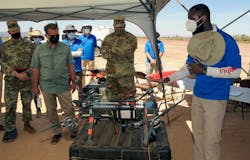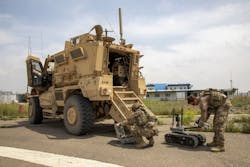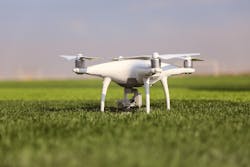Counter-UAV technologies for perimeter security
By Megan Crouse
NASHUA, N.H. - Technologies to counter unmanned aerial vehicles (UAVs) for perimeter security offer a broad spectrum of capabilities and niches. As drones become more inexpensive to deploy, the defenses protecting military bases or other critical facilities must be multi-layered, adaptable and reliable.
In particular, perimeter security means no person — or no autonomous or human-controlled drone — can get in or out of the borders of a facility. Because of their small size and construction materials and flight altitude, some UAVs literally fly under the radar of conventional air defense systems.
Drones can carry a variety of different threats, such as conventional attacks like explosives, spying, or cyber security threats. The defenses against them run the gamut of intelligence; kill and disable; and electronic attacks as well. This effort is known either as counter-unmanned aerial vehicle (C-UAV) or counter-unmanned aerial system (C-UAS).
While creating effective perimeter defenses against drones has been a concern since unmanned aircraft first were designed, recent years have seen efforts within the U.S. Department of Defense (DOD) to formalize and consolidate the available tools, technologies, and strategies.
A rapidly changing threat
For context, look at the guidelines released in 2018 by the U.S. Department of Homeland Security. One useful resource in those guidelines is the National UrbanIt’s important to ask these questions because drones are increasingly common. This growing UAV industry presents new challenges to military and commercial perimeter security concerns. In terms of non-military installations, drone security may be a useful layer of protection for commercial airports, sporting events, prisons, law enforcement facilities and more.
In 2022, DOD leaders say they plan to spend at least $636 million on counter-UAV research and development, and at least $75 million on C-UAV procurement. That’s a $134-million increase from 2021, according to the Congressional Research Service.
State of the industry
“What we are seeing in terms of companies with autonomous vehicles is the recognition that not only are we creating counter-UAV to protect from our enemies but our enemies are doing the same,” says Robin Wessel, CEO of data security company CDSG in Vancouver, Wash. “The data on those assets is very, very important. There is a lot of focus on ensuring, for example, if a drone was to get knocked out by a countermeasure behind enemy lines that its data is secure and protected. Basically it requires utilizing multiple layers. When these assets — say, a drone — is recovered by the enemy, that data may be encrypted and they usually have all the time in the world to crack it … It’s potentially a ticking time bomb for customers or users. Our technologies incorporate multiple layers to ensure that they might infiltrate one of the safeguards but to get becomes exponentially more difficult. I like to think of it as a moat behind a castle. We draw the drawbridge up.”
In 2016, Military & Aerospace Electronics magazine wrote about “the dawn” of counter-drone technologies. Six years later, we’ve come to a morning filled with options. As CDSG’s Wessel points out, although the technology is moving very quickly, the military tends to be relatively slow in adoption. However, today there are a wide variety of different types of anti-drone countermeasures.
“UAV is a constantly evolving threat because it is the fusion between software (cyber) and physical threats,” Wessel says. It faces “Requirements for constant code updates that can defeat RF solutions that profile drone data streams, swarming technologies that can easily overwhelm current C-UAV technologies and fully autonomous UAV threats that don’t depend on RF C2 (command and control) links to execute their mission.”
Inside and outside military applications, the counter-UAV market divides into three segments: critical infrastructure, which includes patrolling airports or other facilities; gathering intelligence information about adversary capabilities and locations; and complex situations such as tracking active threats and investigating possible conspiracies to commit harm either inside the U.S. or internationally.
Civilian applications, such as a private company that wants protection from UAV principally from cyber and espionage threats, can’t use C-UAV technologies because of FCC, FAA, and other regulations, Wessel points out.
For another example, Northrop Grumman Corp. of Falls Church, Va., advertises layered defense including kinetic and non-kinetic effects, aerial and ground sensors, and the battle-hardened, proven and deployed Forward Area Air Defense Command and Control (FAAD C2). The FAAD C2 project was selected by the DOD in 2020 as the interim joint common command and control system for future C-UAV procurements.
There also is some crossover in this field with high-energy lasers, which are being tested by the U.S. Navy and by other branches of the U.S. military. They are being proposed as a cost-effective way to counter UAVs.
Armed forces seek technology demonstrations throughout 2021
2021’s technology demonstrations were just the latest in a line of exploration between the military and industry. The April 2017 Army Techniques Publication 3-01.81, Counter-Unmanned Aircraft System Techniques, outlines various methods. It also places U-UAV within the Army’s six-layer air and missile defense tiers.
In 2019 several DOD organizations demonstrated component technology in Black Dart, a C-UAV exercise intended to assess and validate these systems in the real world. Following that, a January 2021 DOD strategy document about C-UAV outlined the results of studying 10 different technologies across the armed forces. This was in part an effort to cut down on redundancy, in which each branch worked on separate systems.
One of the results was a technology demonstration at the Yuma Proving Ground, Ariz., in April 2021. A collaboration between the Air Force, the Joint Counter-sUAS Office (JCO), and the Army Rapid Capabilities and Critical Technologies Office (RCCTO), it provided industry an assessment from the armed forces about how well each technology performed. In particular, the demonstration sought technologies able to defend against drones with minimal damage to the area or personnel around the conflict — particularly in urban settings.
“This was the first of many industry opportunities as we look to synchronize solutions and counter the small UAV threat,” said Lt. Gen. L. Neil Thurgood, director of Hypersonics, Directed Energy, Space and Rapid Acquisition, which includes the RCCTO. “Events like this demonstration at Yuma Proving Ground will help identify new approaches, focus our efforts, and allow us to leverage innovation quickly.”
Aurora makes the Modular Intercept Drone Avionics Set (MIDAS), an artificial intelligence (AI)-enabled, multi-rotor small UAV. Its autonomous solution takes cues from ground radar and locks on with an onboard sensor. It’s equipped with optical sensors and designed to defeat several small UAVs per flight with low-collateral effects.
“Demonstrating MIDAS’s differentiated Counter-UAV capabilities in such a challenging environment was invaluable,” says Kel Jackson, Counter-UAV program manager for Aurora Flight Sciences.
ELTA North America also emphasized work in the autonomy space in their statements to the RCCTO.
“We all know warfighters are wearing multiple hats as it is, so having something connected to the network that is fully autonomous is crucial,” says Dean Nohe, senior director of business development for ELTA North America. The company’s Drone-Kill-Drone system “takes the network or sensor feed and assigns the right drone to the right threat. Once it gets close to the target, there’s on-board processing and on-board AI that enables an optical target lock and continues the autonomous guidance to the drone until interception.”
This system “uses a combination of on-board processing, autonomous flight control, and optical target lock to strike the target while in flight,” incorporating an entanglement net. It can also be integrated with other effector payloads, drone detection sensors or C2 systems.
As for XTEND, they demonstrated SKYLORD GRIFFON system, an augmented-reality-based system designed for operators with no previous flight experience after three days of training.
Ido Baron, vice president of business development and sales for XTEND, emphasized that most of the cost of the system is contained in the cost in the C2 system and software, which remains relatively protected on the ground.
“The CUAS system flies by C2 but once it comes within range of the drone, the operator takes control so they can investigate the target to either intercept it or follow it,” according to the materials from RCCTO.
Detection
There are several ways to detect incoming or local UAVs in the field, whether at a commercial airport or a military base. Radar is the obvious choice, but UAVs may be too fast or too small to produce a signature radar can detect. Visible-light cameras, infrared sensors, or acoustic sensors all have their own advantages and disadvantages when used as C-UAV.
Visible-light cameras have the ability to record and store images easily for forensic evidence or other review later. However, they need to work with the right software or expert personnel to tell a drone from a bird or other small aircraft. To this day, many have high false-alarm rates. Naturally, they also can have limited capacity in the dark or in bad weather, depending on the camera’s capabilities.
Radio frequency sensors like radar can detect the wireless signals that control the drones. However, RF becomes useless if the UAV is truly autonomous and isn’t sending or receiving any signal from an operating base. Like microphones, it’s also less useful in urban settings because of RF interference from radios, cell phones, and other wireless devices.
Effective counter-UAV operations not only require the ability to detect an object, but also to identify it. Is it a drone or a bird? So, most tools for detection must also include some kind of identification element.
Effectors
Under the category of effectors falls technology that can disable or destroy a drone before it completes its mission. These can be as varied as guns, other aircraft, or nets, or even trained birds such as eagles.
Depending on the tool or technology, there are a combination of options in terms of letting the operators either kill or simply observe drones. For example, the Marine Corps Marine Air Defense Integrated System (MADIS) employs jamming and weaponry. The Marines demonstrated MADIS in July 2019 when crew members aboard the amphibious assault ship USS Boxer neutralized an Iranian UAV.
The MADIS radar and electronic warfare array can mount on a vehicle, but effectors can come in a variety of sizes, weights, and footprints from hand-held anti-drone net guns to ground emplacements. It includes components such as the joint light tactical vehicle (JLTV) from Oshkosh Defense in Oshkosh, Wis.; the RPS-42 light air-search radar from RADA in Germantown, Md.; the MODI II electronic warfare system from Sierra Nevada Corp. in Sparks, Nev.; and electro-optical sensors from Lockheed Martin Corp. in Bethesda, Md.
Jamming devices that can break the link between the UAV and the operator can be a useful asset here. These devices can be portable, often 5 to 10 pounds, or as heavy as hundreds of pounds. The Navy also is exploring dazzlers to counter UAV sensors.
Another important element of this is command and control and other digital or electronic effectors. The Army and Navy have partnered with the Pentagon’s Defense Digital Service in Washington to help work on cyber defense in this area.
Cyber security efforts are important to combat enemy drones on a digital level as well as to secure friendly systems in the case of their capture or incomplete destruction.
“In the near future, we’ll essentially have a network of flying computers in the sky, and just like the computers we use today, drones can be hacked if not secured properly,” says Amir Husain, CEO and founder of SparkCognition and SkyGrid, both located in Austin, Texas.
Their product protects drones from zero-day attacks by using an airspace management system with artificial intelligence. SparkCognition’s DeepArmor and SkyGrid’s airspace management system, AeriosOS, work together, and can be mounted on drones with limited processing power and without network connectivity.
“Unlike traditional anti-malware reliant on signatures of known threats, our AI models don’t require an existing threat database,” Husain says. “However, it’s still important to store data from a threat once it’s detected. This will allow our models to learn the DNA of each threat and detect similar threats that may emerge.”
Kill/disable
The DOD is investigating conventional weaponry and high-energy lasers to develop an efficient and cost-effective defense screen against drones.
Another more unusual effort is a collaborative electromagnetic pulse weapon, as demonstrated by the Leonidas project — a collaborative effort Northrop Grumman and Epirus Inc. in Los Angeles. This C-UAV EMP electromagnetic warfare system can work in static or mobile conditions, Northrop Grumman officials say, and incorporates solid-state commercial semiconductor technology. EMP and electromagnetic warfare destroy or disable UAVs by destroying their guidance electronics.
The Leonidas system is a high-power microwave system that can integrate with the DOD-approved FAAD C2. There also are plans to integrate it with the Northrop Grumman’s Integrated Air and Missile Defense Battle Command System (IBCS) command-and-control (C2) systems. This type of attack is versatile,Command and control
Also critical in this area is the command and control (C2) element. Irrespective of technology, the Pentagon is working on a unified approach to C-UAV.
“What all the services have truly embraced is the common command-and-control standards that are being developed as part of this process, which is going to allow the plug-and-play of industry’s emerging technologies,” says U.S. Army Maj. Gen. Sean Gainey, head of the Pentagon’s Joint Counter-Small Unmanned Aircraft Systems Office (JCO).
This is in response to a tension between the number of possible solutions being developed and making sure different tools and tactics can work well with one another. After all, different services and commands buying multiple expensive defenses is not a cost-effective way to counter $100 drones.
By 2020 the armed forces had three different — but compatible — C2 systems in place. Industry can work with JCO for more information about common technical standards that apply across services and technologies. The end goal is a “plug-and-play” approach bringing the variety of technologies available into a common system such as the Army’s FAAD-C2 or a compatible C2 network such as the Air Force’s MEDUSA.
Even further consolidation came about with a January 2021 Counter-Small Unmanned Aircraft Systems Strategy from the Pentagon, the first department-wide framework for counter-small UAV technology.
What else is in the field now?
The next frontier for counter-UAV may be about tracking and effecting not just single drones, but many at a time. Defending against swarms — large numbers of small drones networked together but physically unobtrusive enough to slip through most defenses — has been and continues to be a priority. One way being explored to do this is with “suicide drones,” or human-guided missiles intended to break up swarms.
In 2020, the U.S. Army tapped Syracuse Research Corp. (SRC) in North Syracuse, N.Y., for development, production, deployment, and support of the Expeditionary-Low, Slow, Small Unmanned Aircraft System Integrated Defeat System (E-LIDS). This $425.9 million five-year project will be designed to defend against drone-mounted explosives and more sophisticated uses such as cyber warfare or intelligence gathering facilitated by small drones.
The Army also contracted the Leonardo DRS Land Systems segment in St. Lewis, MO in 2020 for a $189.8 million five-year contract to develop and build the Mobile-Low, Slow, Small Unmanned Aircraft System Integrated Defeat System (M-LIDS) to counter weaponized versions (specifically improvised explosive devices) of inexpensive drones like commercial quadcopters.
In total, the JCO has endorsed seven defensive systems and one standard architecture for C2.
What’s next?
CDSG’s Wessel predicts that improved C-UAV technologies will see the rise of sensor fusion and AI based profiling. They’ll also come to be in an age with increased legislation, mandated UAV product technology requirements, and integration of traffic management with C-UAV. The latter is essential to minimize the threat of bad actors using COTS UAV solutions such as the FAA’s Unmanned Aircraft System Traffic Management (UTM).
Overall, counter-UAV is still a growing and changing area. As evidenced by the 2021 guiding documents from the Pentagon, the process of making drone defenses widely applicable and also compatible with each other and across services is an ongoing challenge. In the broad sense, it faces the same challenges as any other military technology: keeping pace with technology, fitting into existing doctrine and maximizing the effectiveness of missions and efforts.
“We don’t see the counter-UAV problem set as one enduring solution, we see it as a range of capabilities integrated into a common … [command-and-control system] that gives you the ability to address threats across the range of threats out there, and have the ability to keep up with the pace of” evolving challenges, The JCO Gainey says.
In the future, JCO will host biannual industry days similar to the 2021 Yuma Proving Ground demonstrations, Gainey says.





